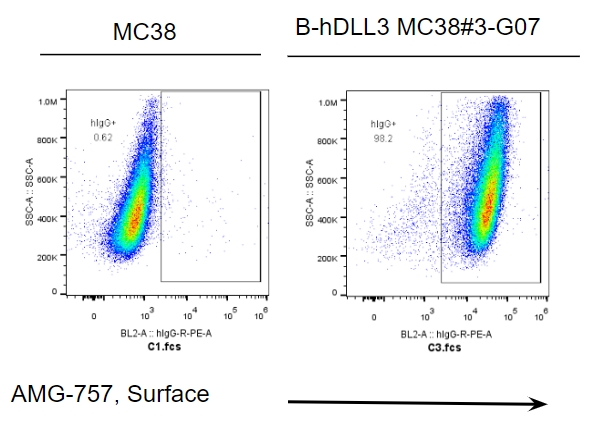Basic Information
Description
The mouse Dll3 gene was replaced by the human DLL3 coding sequence in B-hDLL3 MC38 cells. Human DLL3 is highly expressed on the surface of B-hDLL3 MC38 cells.
-
Targeting strategy

-
Gene targeting strategy for B-hDLL3 MC38 cells. The exogenous promoter and human DLL3 coding sequence was inserted to replace part of murine exon 2 and all of exon 5. The insertion disrupts the endogenous murine Dll3 gene, resulting in a non-functional transcript.
-
Protein Expression Analysis

-

DLL3 expression analysis in B-hDLL3 MC38 cells by flow cytometry. Single cell suspensions from wild-type MC38 and B-hDLL3 MC38 cultures were stained with anti-human DLL3 antibody AMG-757 (in house). Human DLL3 was detected on the surface of B-hDLL3 MC38 cells but not wild-type MC38 cells. The 3-G07 clone of B-hDLL3 MC38 cells was used for in vivo experiments.
-
Tumor growth curve & Body weight changes

-

Subcutaneous homograft tumor growth of B-hDLL3 MC38 cells.
B-hDLL3 MC38 cells (5×105) and wild-type MC38 cells (5×105) were subcutaneously implanted into C57BL/6 mice (female, 7-week-old). Tumor volume and body weight were measured twice a week. (A) Average tumor volume ± SEM. (B) Body weight (Mean± SEM). Volume was expressed in mm3 using the formula: V=0.5 X long diameter X short diameter2. As shown in panel A, B-hDLL3 MC38 cells were able to establish tumors in vivo and can be used for efficacy studies.

Subcutaneous homograft tumor growth of B-hDLL3 MC38 cells. B-hDLL3 MC38 cells (3×106) and wild-type MC38 cells (5×105) were subcutaneously implanted into C57BL/6 mice (female, 8-week-old, n=8). Tumor volume and body weight were measured twice a week. (A) Average tumor volume ± SEM. (B) Body weight (Mean± SEM). Volume was expressed in mm3 using the formula: V=0.5 X long diameter X short diameter2. As shown in panel A, B-hDLL3 MC38 cells were able to establish tumors in vivo and can be used for efficacy studies.

Subcutaneous homograft tumor growth of B-hDLL3 MC38 cells. B-hDLL3 MC38 cells (1×106) and wild-type MC38 cells (5×105) were subcutaneously implanted into B-hCD3E mice (female, 7-week-old, n=6). Tumor volume and body weight were measured twice a week. (A) Average tumor volume ± SEM. (B) Body weight (Mean± SEM). Volume was expressed in mm3 using the formula: V=0.5 X long diameter X short diameter2. As shown in panel A, B-hDLL3 MC38 cells were able to establish tumors in vivo and can be used for efficacy studies.

Subcutaneous homograft tumor growth of B-hDLL3 MC38 cells. B-hDLL3 MC38 cells (5×105) and wild-type MC38 cells (5×105) were subcutaneously implanted into heterozygous B-hCD3E/hDLL3 mice (male, 7-week-old, n=6). Tumor volume and body weight were measured twice a week. (A) Average tumor volume ± SEM. (B) Body weight (Mean± SEM). Volume was expressed in mm3 using the formula: V=0.5 X long diameter X short diameter2. As shown in panel A, B-hDLL3 MC38 cells were able to establish tumors in vivo and can be used for efficacy studies.
-
Protein expression analysis of tumor cells

-

B-hDLL3 MC38 cells were subcutaneously transplanted into B-hCD3E mice (n=6), and on 28 days post inoculation, tumor cells were harvested and assessed for human DLL3 expression by flow cytometry using anti-human DLL3 antibody AMG-757 (in house). As shown, human DLL3 was expressed on the surface of tumor cells. Therefore, B-hDLL3 MC38 cells can be used for in vivo efficacy studies of novel DLL3 therapeutics.
-
In vivo efficacy of CD3 BsAb

-

Antitumor activity of bispecific antibody (BsAb) X in B-hCD3E mice. B-hDLL3 MC38 cells were subcutaneously implanted into B-hCD3E mice (female, 8 week-old, n=6). Mice were grouped when the tumor size was approximately 100 mm3, at which time they were treated with BsAb X provided by the client with doses and schedules indicated in panel. (A) Tumor volume changes during treatment. (B) Body weight changes during treatment. As shown in panel A, BsAb X was efficacious in controlling tumor growth in B-hCD3E mice, demonstrating that the B-hCD3E mouse model is a powerful tool for in vivo efficacy study of T cell bispecific antibody. Values are expressed as mean ± SEM.


